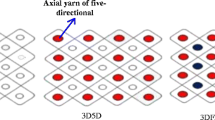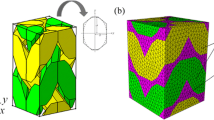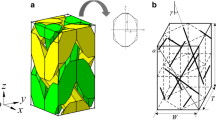Abstract
Cut-edge is a kind of damage for the three-dimensional four-directional (3D4d) braided composites which is inevitable because of machining to meet requisite shape and working in the abominable environment. The longitudinal tensile experiment of the 3D4d braided composites with different braiding angles between cut-edge and the ones without cut-edge was conducted. Then representative volume cell (RVC) with interface zones was established to analyze the tensile properties through the fracture and damage mechanics. The periodic boundary conditions under the cut-edge and uncut-edge conditions were imposed to simulate the failure mechanism. Stress-strain distribution and the damage evolution nephogram in cut-edge condition were conducted. Numerical results were coincident with the experimental results. Finally the variation of cut-edge effect with the specimen thickness was simulated by superimposing inner cells. The consequence showed that thickness increase can effectively reduce cut-edge influence on longitudinal strength for 3D4d braided composites. Cut-edge simulation of braided composites has guiding significance on the actual engineering application.

















Similar content being viewed by others
References
Liu Z.G.: Study on comparison of manufacturing methods of high performance composites pipes and application of 3D braiding technology. J. Mater. Eng. 2, 109–111 (2009)
Tang Z.X., Postle R.: Mechanics of three-dimensional braided structures for composite materialsII:prediction of the elastic modulus. Compos. Struct. 54, 451–457 (2001)
Shokrieh M., Mazloomi M.: A new analytical model for calculation of stiffness of three-dimensional four directional braided composites. Compos. Struct. 94, 1005–1015 (2012)
Sun H.Y., Qiao X.: Prediction of the mechanical properties of 3-dimensional braided composites. Compos. Sci. Technol. 57, 623–629 (1997)
Ishikawa T., Chou T.W.: Stiffness and strength behavior of woven fabric composites. J. Mater. Sci. 17, 3211–3220 (1982)
Kalidindi S.R., Abusafieh A.: Longitudinal and transverse moduli and strengths of low angle 3-D braided composites. J. Compos. Mater. 30, 885–905 (1996)
Macander AB, Crane RM, Camponeschi ET. Fabrication and mechnical properties multidimensionally (X-D) braided composite materials. Composite materials: Testing and design (7th conference). [C] STP. p. 422–43 (1986)
Li J L., Jiao Y N., Y. S.: Experimental investigation of cut-edge effect on mechanical properties of three-dimensional braided composites. Materials and Design. 28, 2417–2424 (2007)
Zhang C., Binienda W.K.: Free-edge effect on the effective stiffness of single-layer triaxially braided composite. Compos. Sci. Technol. 107, 145–153 (2015)
Li D.S., Fang D.N., Jiang N., et al.: Finite element modeling of mechanical properties of 3D five-directional rectangular braided composites. Compos Part B ENG. 42, 1373–1385 (2011)
Zhang C., Xu X.: W, finite element analysis of 3D braided composites based on three unit-cells models. Compos. Struct. 98, 130–142 (2013)
Fang G.D., Liang J., Wang B.L.: Progressive damage and nonlinear analysis of 3D four-directional braided composites under unidirectional tension. Compos. Struct. 89, 126–133 (2009)
Zeng T., Fang D.: N, predicting the nonlinear response and failure of 3D braided composites. Mater. Lett. 58, 3237–3241 (2004)
Hu L. Investigation on progressive damage and failure mechanism of three dimensional braided composites [D]. Dissertation, Beihang University, 55–65 (2015)
Wang Y.Q., Wang A.S.D.: Spatial distribution of yarns and mechanical properties in 3D braided tubular composites. Appl. Compos. Mater. 4, 121–132 (1997)
Li D.S., Fang D.N., Lu Z.X., Yang Z.Y., Jiang N.: Finite element analysis of mechanical properties of 3D four directional rectangular braided composites part 2:validation of 3D finite element model. Appl. Compos. Mater. 7, 389–404 (2010)
Xia B., Yang Z Y.: Investigation on the tensile properties of three-dimensional full five-directional braided composites. Comp Mater Sci. 77, 445–455 (2013)
Li D.S., Li J.L.: Chen Li.Finite Element analysis of mechanical properties of 3D four-directional rectangular braided composites. Appl. Compos. Mater. 17, 373–387 (2010)
Xu K.: Xu X W. Finite element analysis of mechanical properties of 3D five-directional braided composites. Mat Sci ENG A-Struct. 487, 499–509 (2008)
Sun H., CC W.: Experimental research on mechanical properties of composite materials with textile structure. J Exp Mech. 012, 335–341 (1997)
Zhao Q., Jin L., Jiang L., Zhang Y., Sun B.: Experimental characterizations of bending fatigue of a four-step 3-D braided rectangular composite under different stress levels. J. Reinf. Plast. Compos. 30(1571–1582), (2011)
Rawal A., Sibal A., Saraswat H.: Tensile behaviour of regular triaxial braided structures. Mech. Mater. 91(277–289), (2015)
D’Amato E.: Experiments on single layer textile composites. Compos. Struct. 55(217–223), (2002)
Xie D., Biggers S B.: Calculation of transient strain energy release rates under impact loading based on the virtual crack closure technique. Impact Eng. 34, 1047–1060 (2007)
Fang G.D., Liang J.: Effect of interface properties on mechanical behavior of 3D four-directional braided composites with large braid angle subjected to uniaxial tension. Appl. Compos. Mater. 18, 449–465 (2011)
Shriram S., Pagano N J., Somnath G.: Analysis of interfacial debonding in three-dimensional composite microstructures. J ENG MATER-T ASME. 128, 96–106 (2005)
Hashin Z.: Failure criteria for unidirectional fiber composites. J. Appl. Mech. 47, 329–334 (1980)
Cordebois J., Sidoroff F.: Damage induced elastic anisotropy, Mechanical behavior of anisotropic solids. Comportment mechanique des Solids Anisotropes. 24, 761–774 (1982)
Author information
Authors and Affiliations
Corresponding author
Rights and permissions
About this article
Cite this article
Lei, B., Liu, Z., Ya, J. et al. Bearing Abilities and Progressive Damage Analysis of Three Dimensional Four-Directional Braided Composites with Cut-Edge. Appl Compos Mater 23, 839–856 (2016). https://doi.org/10.1007/s10443-016-9488-1
Received:
Accepted:
Published:
Issue Date:
DOI: https://doi.org/10.1007/s10443-016-9488-1




